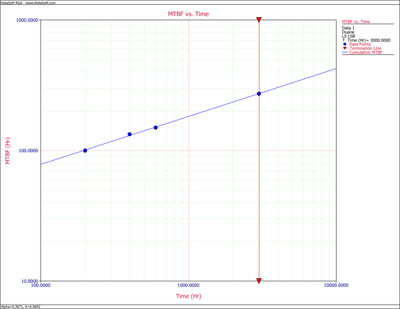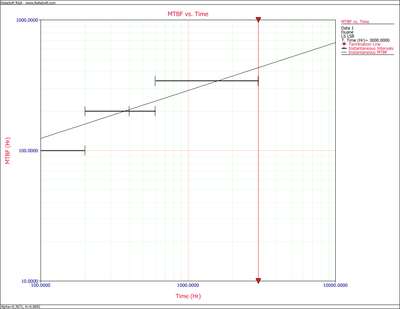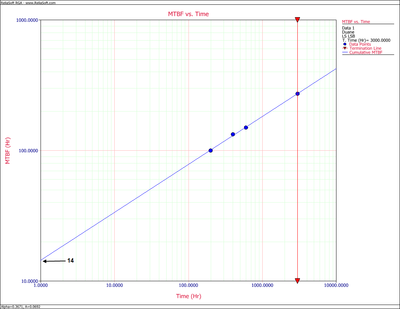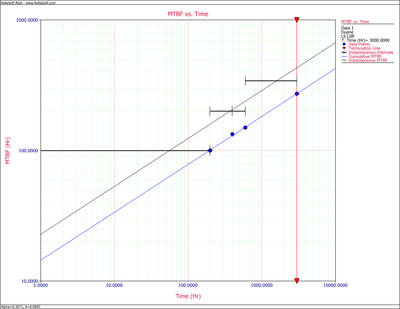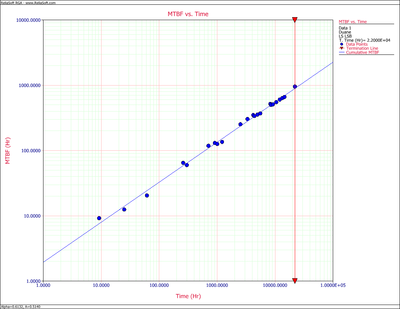Template:Parameter estimation duane
Parameter Estimation
The Duane model is a two parameter model. Therefore, to use this model as a basis for predicting the reliability growth that could be expected in an equipment development program, procedures must be defined for estimating these parameters as a function of equipment characteristics. Note that, while these parameters can be estimated for a given data set using curve-fitting methods, there exists no underlying theory for the Duane model that could provide a basis for a priori estimation.
Graphical Method
Eqn. (duaneb) may be linearized by taking the natural log of both sides:
- [math]\displaystyle{ \ln \left( {{\widehat{{\bar{\lambda }}}}_{c}} \right)=\ln \left( \frac{1}{b} \right)-\alpha \ln (T) }[/math]
Consequently, plotting [math]\displaystyle{ \widehat{{\bar{\lambda }}} }[/math] versus [math]\displaystyle{ T }[/math] on log-log paper will result in a straight line with a negative slope, such that:
- [math]\displaystyle{ ln{\frac{1}{b}}=\text{the y-intercept at T}=1 }[/math]
- [math]\displaystyle{ \frac{1}{b}=\text{the cumulative failure intensity at T}=1 }[/math]
- [math]\displaystyle{ \alpha=\text{the slope of the straight line on the log-log plot} }[/math]
Similarly, Eqn. (duane6) can also be linearized by taking the natural log of both sides:
Plotting [math]\displaystyle{ \hat{m} }[/math] versus [math]\displaystyle{ T }[/math] on log-log paper will result in a straight line with a positive slope such that:
- [math]\displaystyle{ \ln{b}=\text{the y-intercept at T}=1 }[/math]
- [math]\displaystyle{ b=\text{the cumulative mean time between failure at T}=1 }[/math]
- [math]\displaystyle{ \alpha=\text{the slope of the straight line on the log-log plot} }[/math]
Two ways of determining these curves are as follows:
- 1.Predict the [math]\displaystyle{ {{\widehat{{\bar{\lambda }}}}_{0}} }[/math] and [math]\displaystyle{ \hat{m}= }[/math] [math]\displaystyle{ \tfrac{1}{{{\widehat{{\bar{\lambda }}}}_{0}}} }[/math] of the system from its reliability block diagram and available component failure intensities. Plot this value on log-log plotting paper at [math]\displaystyle{ T=1. }[/math] From past experience and from past data for similar equipment, find values of [math]\displaystyle{ {{\alpha }_{1}} }[/math] , the slope of the improvement lines for [math]\displaystyle{ \widehat{{\bar{\lambda }}} }[/math] or [math]\displaystyle{ \hat{m} }[/math] . Modify this [math]\displaystyle{ \alpha }[/math] as necessary. If a better design effort is expected and a more intensive research, test and development or TAAF program is to be implemented, then a [math]\displaystyle{ 15% }[/math] improvement in the growth rate may be attainable. Consequently, the available value for slope [math]\displaystyle{ \alpha }[/math] , and [math]\displaystyle{ {{\alpha }_{1}} }[/math] , should be adjusted by this amount. The value to be used will then be [math]\displaystyle{ \alpha =1.15{{\alpha }_{1}}. }[/math] A line is then drawn through point [math]\displaystyle{ {{\widehat{{\bar{\lambda }}}}_{0}} }[/math] and [math]\displaystyle{ T=1 }[/math] with the just determined slope [math]\displaystyle{ \alpha }[/math] , keeping in mind that [math]\displaystyle{ \alpha }[/math] is negative for the [math]\displaystyle{ \widehat{{\bar{\lambda }}} }[/math] curve. This line should be extended to the design, development and test time scheduled to be expended to see if the failure intensity goal will indeed be achieved on schedule. It is also possible to find that the design, development and test time to achieve the goal may be earlier than the delivery date or later. If earlier, then either the reliability program effort can be judiciously and appropriately trimmed; or if it is an incentive contract, full advantage is taken of the fact that the failure intensity goal can be exceeded with the associated increased profits to the company. A similar approach may be used for the MTBF growth model, where [math]\displaystyle{ {{\hat{m}}_{0}}=\tfrac{1}{{{\widehat{{\bar{\lambda }}}}_{0}}} }[/math] is plotted at [math]\displaystyle{ T=1 }[/math] , and a line is drawn through the point [math]\displaystyle{ {{\hat{m}}_{0}} }[/math] and [math]\displaystyle{ T=1 }[/math] with slope [math]\displaystyle{ \alpha }[/math] to obtain the MTBF growth line. If [math]\displaystyle{ \alpha }[/math] values are not available, consult Table 4.1, which gives actual [math]\displaystyle{ \alpha }[/math] values for various types of equipment. These have been obtained from the literature or by MTBF growth tests. It may be seen from Table 4.1 that [math]\displaystyle{ \alpha }[/math] values range between 0.24 and 0.65. The lower values reflect slow early growth and the higher values reflect fast early growth.
| Equipment | Slope([math]\displaystyle{ \alpha }[/math]) | |
|---|---|---|
| Computer system | Actual | 0.24 |
| Easy to find failures were eliminated | 0.26 | |
| All known failure causes were eliminated | 0.36 | |
| Mainframe computer | 0.50 | |
| Aerospace electronics | All malfunctions | 0.57 |
| Relevant failures only | 0.65 | |
| Attack radar | 0.60 | |
| Rocket engine | 0.46 | |
| Afterburning turbojet | 0.35 | |
| Complex hydromechanical system | 0.60 | |
| Aircraft generator | 0.38 | |
| Modern dry turbojet | 0.48 |
- 2) During the design, development and test phase and at specific milestones, the [math]\displaystyle{ \widehat{{\bar{\lambda }}}=\tfrac{1}{{\hat{m}}} }[/math] is calculated from the total failures and [math]\displaystyle{ T }[/math] values. These values of [math]\displaystyle{ \widehat{{\bar{\lambda }}} }[/math] or [math]\displaystyle{ \hat{m} }[/math] are plotted above the corresponding [math]\displaystyle{ T }[/math] values on log-log paper. A straight line is drawn favoring these points to minimize the distance between the points and the line, thus establishing the improvement or growth model and its parameters graphically. If needed, linear regression analysis techniques can be used to determine these parameters.
Example 1
A complex system's reliability growth is being monitored and the data set is given in Table 4.2.
Do the following:
- 1) Plot the cumulative MTBF growth curve.
- 2) Write the equation of this growth curve.
- 3) Write the equation of the instantaneous MTBF growth model.
- 4) Plot the instantaneous MTBF growth curve.
| Point Number | Cumulative Test Time(hr) | Cumulative Failures | Cumulative MTBF(hr) | Instantaneous MTBF(hr) |
|---|---|---|---|---|
| 1 | 200 | 2 | 100.0 | 100 |
| 2 | 400 | 3 | 133.0 | 200 |
| 3 | 600 | 4 | 150.0 | 200 |
| 4 | 3,000 | 11 | 273.0 | 342.8 |
Solution
- 1) Given the data in the second and third columns of Table 4.2, the cumulative MTBF, [math]\displaystyle{ {{\hat{m}}_{c}} }[/math] , values are calculated in the fourth column. The information in the second and fourth columns is then plotted. Figure figold72 shows the cumulative MTBF while Figure figold72a shows the instantaneous MTBF. It can be seen that a straight line represents the MTBF growth very well on log-log scales.
By changing the x-axis scaling, you are able to extend the line to [math]\displaystyle{ T=1 }[/math] . You can get the value of [math]\displaystyle{ b }[/math] from the graph by positioning the cursor at the point where the line meets the y-axis. Then read the value of the y-coordinate position at the bottom left corner. In this case, [math]\displaystyle{ b }[/math] is approximately [math]\displaystyle{ 14 }[/math] hr. Figure figold73 illustrates this.
Another way of determining [math]\displaystyle{ b }[/math] is to calculate [math]\displaystyle{ \alpha }[/math] by using two points on the fitted straight line and substituting the corresponding [math]\displaystyle{ {{\hat{m}}_{c}} }[/math] and [math]\displaystyle{ T }[/math] values into:
- [math]\displaystyle{ \alpha =\frac{\ln \left( {{{\hat{m}}}_{{{c}_{2}}}} \right)-\ln \left( {{{\hat{m}}}_{{{c}_{1}}}} \right)}{\ln \left( {{T}_{_{2}}} \right)-\ln \left( {{T}_{_{1}}} \right)} }[/math]
Then substitute this [math]\displaystyle{ \alpha }[/math] and choose a set of values for [math]\displaystyle{ {{\hat{m}}_{{{c}_{1}}}} }[/math] and [math]\displaystyle{ {{T}_{_{1}}} }[/math] into Eqn. (duane6) and solve for [math]\displaystyle{ b }[/math] . The slope of the line, [math]\displaystyle{ \alpha }[/math] , may also be found from Eqn. (eq73) or from:
- [math]\displaystyle{ \alpha =\frac{\ln \left( {{{\hat{m}}}_{c}} \right)-\ln (b)}{\ln (T)-\ln (1)} }[/math]
Using the plot in Figure figold72, at [math]\displaystyle{ {{T}_{_{1}}}=200 }[/math] hr, [math]\displaystyle{ {{\hat{m}}_{{{c}_{1}}}}=100 }[/math] hr. At [math]\displaystyle{ {{T}_{_{2}}}=3,500 }[/math] hr, [math]\displaystyle{ {{\hat{m}}_{{{c}_{2}}}}=300 }[/math] hr. From Figure figold73, at [math]\displaystyle{ b=14 }[/math] hr when [math]\displaystyle{ T=1 }[/math] .
Substituting the first set of values, [math]\displaystyle{ b=14 }[/math] hr and [math]\displaystyle{ \ln 1=0 }[/math] , into Eqn. (eq77) yields:
- [math]\displaystyle{ \begin{align} & {{\alpha }_{1}}= & \frac{\ln (100)-\ln (14)}{\ln (200)-\ln (1)} \\ & = & 0.3711 \end{align} }[/math]
- 2. Substituting the second set of values, [math]\displaystyle{ b=14 }[/math] hr and [math]\displaystyle{ \ln 1=0, }[/math] into Eqn. (eq77) yields:
- [math]\displaystyle{ \begin{align} & {{\alpha }_{2}}= & \frac{\ln (300)-\ln (14)}{\ln (3,500)-\ln (1)} \\ & = & 0.3755 \end{align} }[/math]
Averaging these two [math]\displaystyle{ \alpha }[/math] values yields a better estimate of [math]\displaystyle{ \widehat{\alpha }=0.3733 }[/math] .
- 3. Now the equation for the cumulative MTBF growth curve is:
[math]\displaystyle{ {{\hat{m}}_{c}}=14\cdot {{T}^{\text{ }0.3733}} }[/math]
- 4. The equation for the instantaneous MTBF growth curve using Eqn. (eq76) is:
Eqn. (eq80) is plotted in Figures figold72a and figold72b. In Figure figold72b, you can see that a parallel shift upward of the cumulative MTBF, [math]\displaystyle{ {{\hat{m}}_{c}} }[/math] , line by a distance of [math]\displaystyle{ \tfrac{1}{1-\alpha } }[/math] gives the instantaneous MTBF, or the [math]\displaystyle{ {{\hat{m}}_{i}} }[/math] , line.
Least Squares (Linear Regression)
The parameters can also be estimated using a mathematical approach. To do this, apply least squares analysis on Eqn. (eq73):
- [math]\displaystyle{ \ln ({{\hat{m}}_{c}})=\ln (b)+\alpha \ln (T) }[/math]
And for simplicity in the calculations, let:
- [math]\displaystyle{ \begin{align} & \ln ({{m}_{ci}})= & {{Y}_{i}} \\ & \ln (b)= & a \\ & \alpha = & c \\ & \ln ({{T}_{i}})= & {{X}_{i}} \end{align} }[/math]
Therefore, Eqn. (mc) becomes:
- [math]\displaystyle{ {{Y}_{i}}=\widehat{a}+\widehat{c}{{X}_{i}} }[/math]
Assume that a set of data pairs [math]\displaystyle{ ({{X}_{1}},{{Y}_{1}}) }[/math] , [math]\displaystyle{ ({{X}_{2}},{{Y}_{2}}) }[/math] ,..., [math]\displaystyle{ ({{X}_{N}},{{Y}_{N}}) }[/math] were obtained and plotted. Then according to the Least Squares Principle, which minimizes the vertical distance between the data points and the straight line fitted to the data, the best fitting straight line to this data set is the straight line [math]\displaystyle{ Y=\widehat{a}+\widehat{c}X }[/math] such that:
- [math]\displaystyle{ \underset{i=1}{\overset{N}{\mathop \sum }}\,{{(\widehat{a}+\widehat{c}{{X}_{i}}-{{Y}_{i}})}^{2}}=\underset{(a,c)}{\mathop{min}}\,\underset{i=1}{\overset{N}{\mathop \sum }}\,{{(a+c{{X}_{i}}-{{Y}_{i}})}^{2}} }[/math]
And where [math]\displaystyle{ \widehat{a} }[/math] and [math]\displaystyle{ \widehat{c} }[/math] are the least squares estimates of [math]\displaystyle{ a }[/math] and [math]\displaystyle{ c }[/math] . To obtain [math]\displaystyle{ \widehat{a} }[/math] and [math]\displaystyle{ \widehat{c} }[/math] , let:
- [math]\displaystyle{ F=\underset{i=1}{\overset{N}{\mathop \sum }}\,{{(a+c{{X}_{i}}-{{Y}_{i}})}^{2}} }[/math]
Differentiating [math]\displaystyle{ F }[/math] with respect to [math]\displaystyle{ a }[/math] and [math]\displaystyle{ c }[/math] yields:
- [math]\displaystyle{ \frac{\partial F}{\partial a}=2\underset{i=1}{\overset{N}{\mathop \sum }}\,(a+c{{X}_{i}}-{{Y}_{i}}) }[/math]
- and:
- [math]\displaystyle{ \frac{\partial F}{\partial c}=2\underset{i=1}{\overset{N}{\mathop \sum }}\,(a+c{{X}_{i}}-{{Y}_{i}}){{X}_{i}} }[/math]
Set Eqns. (ls2) and (ls3) equal to zero:
- [math]\displaystyle{ \underset{i=1}{\overset{N}{\mathop \sum }}\,(a+c{{X}_{i}}-{{Y}_{i}})=\underset{i=1}{\overset{N}{\mathop \sum }}\,(\widehat{{{Y}_{i}}}-{{Y}_{i}})=-\underset{i=1}{\overset{N}{\mathop \sum }}\,({{Y}_{i}}-\widehat{{{Y}_{i}}})=0 }[/math]
- and:
- [math]\displaystyle{ \underset{i=1}{\overset{N}{\mathop \sum }}\,(a+c{{X}_{i}}-{{Y}_{i}}){{X}_{i}}=\underset{i=1}{\overset{N}{\mathop \sum }}\,(\widehat{{{Y}_{i}}}-{{Y}_{i}}){{X}_{i}}=-\underset{i=1}{\overset{N}{\mathop \sum }}\,({{Y}_{i}}-\widehat{{{Y}_{i}}}){{X}_{i}}=0 }[/math]
Solve the equations simultaneously:
- and:
- [math]\displaystyle{ \widehat{c}=\frac{\underset{i=1}{\overset{N}{\mathop{\sum }}}\,{{X}_{i}}{{Y}_{i}}-\tfrac{\left( \underset{i=1}{\overset{N}{\mathop{\sum }}}\,{{X}_{i}}\underset{i=1}{\overset{N}{\mathop{\sum }}}\,{{Y}_{i}} \right)}{N}}{\underset{i=1}{\overset{N}{\mathop{\sum }}}\,X_{i}^{2}-\tfrac{{{\left( \underset{i=1}{\overset{N}{\mathop{\sum }}}\,{{X}_{i}} \right)}^{2}}}{N}} }[/math]
Now substituting back [math]\displaystyle{ \ln ({{m}_{ci}})={{Y}_{i}}, }[/math] [math]\displaystyle{ \ln (b)=a, }[/math] [math]\displaystyle{ \alpha =c }[/math] and [math]\displaystyle{ \ln ({{T}_{i}})={{X}_{i}}, }[/math] we have:
- [math]\displaystyle{ \widehat{b}={{e}^{\tfrac{1}{n}\left[ \underset{i=1}{\overset{n}{\mathop{\sum }}}\,\ln ({{m}_{ci}})-\alpha \underset{i=1}{\overset{n}{\mathop{\sum }}}\,\ln ({{T}_{i}}) \right]}} }[/math]
- where:
- [math]\displaystyle{ \widehat{\alpha }=\frac{\underset{i=1}{\overset{n}{\mathop{\sum }}}\,\ln ({{T}_{i}})\ln ({{m}_{ci}})-\tfrac{\underset{i=1}{\overset{n}{\mathop{\sum }}}\,\ln ({{T}_{i}})\underset{i=1}{\overset{n}{\mathop{\sum }}}\,\ln ({{m}_{ci}})}{n}}{\underset{i=1}{\overset{n}{\mathop{\sum }}}\,{{\left[ \ln ({{T}_{i}}) \right]}^{2}}-\tfrac{{{\left( \underset{i=1}{\overset{n}{\mathop{\sum }}}\,\ln ({{T}_{i}}) \right)}^{2}}}{n}} }[/math]
Example 2
Using the data from Table 4.2, estimate the parameters of the MTBF model using least squares.
Solution
From Table 4.2:
- [math]\displaystyle{ \begin{align} & \underset{i=1}{\overset{n}{\mathop \sum }}\,\ln ({{T}_{i}})= & 25.693 \\ & \underset{i=1}{\overset{n}{\mathop \sum }}\,\ln ({{T}_{i}})\ln ({{m}_{ci}})= & 130.66 \\ & \underset{i=1}{\overset{n}{\mathop \sum }}\,\ln ({{m}_{ci}})= & 20.116 \\ & \underset{i=1}{\overset{n}{\mathop \sum }}\,{{\left[ \ln ({{T}_{i}}) \right]}^{2}}= & 168.99 \end{align} }[/math]
From Eqn. (Dalpha):
- [math]\displaystyle{ \begin{align} & \widehat{\alpha }= & \frac{130.66-\tfrac{25.693\cdot 20.116}{4}}{168.99-\tfrac{{{25.693}^{2}}}{4}} \\ & = & 0.3671 \end{align} }[/math]
Also from Eqn. (Dbi):
- [math]\displaystyle{ \begin{align} & \widehat{b}= & {{e}^{\tfrac{1}{4}(20.116-0.3671\cdot 25.693)}} \\ & = & 14.456 \end{align} }[/math]
Therefore, Eqn. (duane6) becomes:
- [math]\displaystyle{ {{\hat{m}}_{c}}=14.456\cdot {{T}^{0.3671}} }[/math]
The equation for the instantaneous MTBF growth curve using Eqn. (eq76) is:
- [math]\displaystyle{ {{\hat{m}}_{i}}=\frac{1}{1-0.3671}(14.456){{T}^{0.3671}} }[/math]
Example 3
For the data given in columns 1 and 2 of Table 4.3, estimate the Duane parameters using least squares.
| (1)Failure Number | (2)Failure Time(hr) | (3)[math]\displaystyle{ \ln{T_i} }[/math] | (4)[math]\displaystyle{ \ln{T_i}^2 }[/math] | (5)[math]\displaystyle{ m_c }[/math] | (6)[math]\displaystyle{ \ln{m_c} }[/math] | (7)[math]\displaystyle{ \ln{m_c}\cdot\ln{T_i} }[/math] |
|---|---|---|---|---|---|---|
| 1 | 9.2 | 2.219 | 4.925 | 9.200 | 2.219 | 4.925 |
| 2 | 25 | 3.219 | 10.361 | 12.500 | 2.526 | 8.130 |
| 3 | 61.5 | 4.119 | 16.966 | 20.500 | 3.020 | 12.441 |
| 4 | 260 | 5.561 | 30.921 | 65.000 | 4.174 | 23.212 |
| 5 | 300 | 5.704 | 32.533 | 60.000 | 4.094 | 23.353 |
| 6 | 710 | 6.565 | 43.103 | 118.333 | 4.774 | 31.339 |
| 7 | 916 | 6.820 | 46.513 | 130.857 | 4.874 | 33.241 |
| 8 | 1010 | 6.918 | 47.855 | 126.250 | 4.838 | 33.470 |
| 9 | 1220 | 7.107 | 50.504 | 135.556 | 4.909 | 34.889 |
| 10 | 2530 | 7.836 | 61.402 | 253.000 | 5.533 | 43.359 |
| 11 | 3350 | 8.117 | 65.881 | 304.545 | 5.719 | 46.418 |
| 12 | 4200 | 8.343 | 69.603 | 350.000 | 5.858 | 48.872 |
| 13 | 4410 | 8.392 | 70.419 | 339.231 | 5.827 | 48.895 |
| 14 | 4990 | 8.515 | 72.508 | 356.429 | 5.876 | 50.036 |
| 15 | 5570 | 8.625 | 74.393 | 371.333 | 5.917 | 51.036 |
| 16 | 8310 | 9.025 | 81.455 | 519.375 | 6.253 | 56.431 |
| 17 | 8530 | 9.051 | 81.927 | 501.765 | 6.218 | 56.282 |
| 18 | 9200 | 9.127 | 83.301 | 511.111 | 6.237 | 56.921 |
| 19 | 10500 | 9.259 | 85.731 | 552.632 | 6.315 | 58.469 |
| 20 | 12100 | 9.401 | 88.378 | 605.000 | 6.405 | 60.215 |
| 21 | 13400 | 9.503 | 90.307 | 638.095 | 6.458 | 61.375 |
| 22 | 14600 | 9.589 | 91.945 | 663.636 | 6.498 | 62.305 |
| 23 | 22000 | 9.999 | 99.976 | 956.522 | 6.863 | 68.625 |
| [math]\displaystyle{ \color{Blue}Sum = }[/math] | [math]\displaystyle{ \color{Blue}173.013 }[/math] | [math]\displaystyle{ \color{Blue}1400.908 }[/math] | [math]\displaystyle{ \color{Blue}7600.870 }[/math] | [math]\displaystyle{ \color{Blue}121.406 }[/math] | [math]\displaystyle{ \color{Blue}974.242 }[/math] |
Solution
To estimate the parameters using least squares, the values in columns 3, 4, 5, 6 and 7 are calculated. The cumulative MTBF, [math]\displaystyle{ {{m}_{c}} }[/math] , is calculated by dividing the failure time by the failure number. From Eqn. (Dalpha), [math]\displaystyle{ \widehat{\alpha } }[/math] is:
- [math]\displaystyle{ \begin{align} & \widehat{\alpha }= & \frac{974.242-\tfrac{173.013\cdot 121.406}{23}}{1400.908-\tfrac{{{(173.013)}^{2}}}{23}} \\ & = & 0.6133 \end{align} }[/math]
The estimator of [math]\displaystyle{ b }[/math] can be estimated from Eqn. (Dbi):
- [math]\displaystyle{ \begin{align} & \widehat{b}= & {{e}^{\tfrac{1}{23}(121.406-0.6133\cdot 173.013)}} \\ & = & 1.9453 \end{align} }[/math]
Therefore, Eqn. (duane6) becomes:
- [math]\displaystyle{ {{\hat{m}}_{c}}=1.9453\cdot {{T}^{0.613}} }[/math]
Using Eqn. (eq76), the equation for the instantaneous MTBF growth curve is:
- [math]\displaystyle{ {{\hat{m}}_{i}}=\frac{1}{1-0.613}(1.945){{T}^{0.613}} }[/math]
Example 4
For the data given in the Table 4.4, estimate the Duane parameters using least squares.
| Run Number | Failed Unit | Test Time 1 | Test Time 2 | Cumulative Time |
|---|---|---|---|---|
| 1 | 1 | 0.2 | 2.0 | 2.2 |
| 2 | 2 | 1.7 | 2.9 | 4.6 |
| 3 | 2 | 4.5 | 5.2 | 9.7 |
| 4 | 2 | 5.8 | 9.1 | 14.9 |
| 5 | 2 | 17.3 | 9.2 | 26.5 |
| 6 | 2 | 29.3 | 24.1 | 53.4 |
| 7 | 1 | 36.5 | 61.1 | 97.6 |
| 8 | 2 | 46.3 | 69.6 | 115.9 |
| 9 | 1 | 63.6 | 78.1 | 141.7 |
| 10 | 2 | 64.4 | 85.4 | 149.8 |
| 11 | 1 | 74.3 | 93.6 | 167.9 |
| 12 | 1 | 106.6 | 103 | 209.6 |
| 13 | 2 | 195.2 | 117 | 312.2 |
| 14 | 2 | 235.1 | 134.3 | 369.4 |
| 15 | 1 | 248.7 | 150.2 | 398.9 |
| 16 | 2 | 256.8 | 164.6 | 421.4 |
| 17 | 2 | 261.1 | 174.3 | 435.4 |
| 18 | 2 | 299.4 | 193.2 | 492.6 |
| 19 | 1 | 305.3 | 234.2 | 539.5 |
| 20 | 1 | 326.9 | 257.3 | 584.2 |
| 21 | 1 | 339.2 | 290.2 | 629.4 |
| 22 | 1 | 366.1 | 293.1 | 659.2 |
| 23 | 2 | 466.4 | 316.4 | 782.8 |
| 24 | 1 | 504 | 373.2 | 877.2 |
| 25 | 1 | 510 | 375.1 | 885.1 |
| 26 | 2 | 543.2 | 386.1 | 929.3 |
| 27 | 2 | 635.4 | 453.3 | 1088.7 |
| 28 | 1 | 641.2 | 485.8 | 1127 |
| 29 | 2 | 755.8 | 573.6 | 1329.4 |
Solution
The solution to this example follows the same procedure as the previous example. Therefore, from Table 4.4:
- [math]\displaystyle{ \begin{align} & \underset{i=1}{\overset{29}{\mathop \sum }}\,\ln ({{T}_{i}})= & 154.151 \\ & \underset{i=1}{\overset{29}{\mathop \sum }}\,\ln {{({{T}_{i}})}^{2}}= & 902.592 \\ & \underset{i=1}{\overset{29}{\mathop \sum }}\,\ln ({{m}_{c}})= & 82.884 \\ & \underset{i=1}{\overset{29}{\mathop \sum }}\,\ln ({{T}_{i}})\cdot \ln ({{m}_{c}})= & 483.154 \end{align} }[/math]
For least squares, Eqn. (Dalpha) is used to estimate [math]\displaystyle{ \alpha }[/math] :
- [math]\displaystyle{ \begin{align} & \widehat{\alpha }= & \frac{483.154-\tfrac{154.151\cdot 82.884}{29}}{902.592-\tfrac{{{(154.151)}^{2}}}{29}} \\ & = & 0.5115 \end{align} }[/math]
The estimator of [math]\displaystyle{ b }[/math] can be estimated from Eqn. (Dbi):
- [math]\displaystyle{ \begin{align} & \widehat{b}= & {{e}^{\tfrac{1}{29}(82.884-0.5115\cdot 154.151)}} \\ & = & 1.1495 \end{align} }[/math]
Therefore, from Eqn. (duane6):
- [math]\displaystyle{ {{\hat{m}}_{c}}=1.1495\cdot {{T}^{0.5115}} }[/math]
Using Eqn. (eq76), the equation for the instantaneous MTBF growth curve is:
- [math]\displaystyle{ {{\hat{m}}_{i}}=\frac{1}{1-0.5115}(1.1495){{T}^{0.5115}} }[/math]
Maximum Likelihood Estimators
In Reliability Analysis for Complex, Repairable Systems (1974), L. H. Crow noted that the Duane model could be stochastically represented as a Weibull process, allowing for statistical procedures to be used in the application of this model in reliability growth. This statistical extension became what is known as the Crow-AMSAA (NHPP) model. The Crow-AMSAA provides a complete Maximum Likelihood Estimation (MLE) solution to the Duane model. This is described in detail in Chapter 5.
